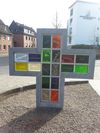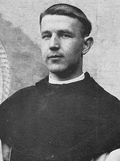

|
|
|
|
|
|
The fallen resistance people in Limburg
Père Hugues /Pater Hugo Jacobs
(Karel)
∗ 17-11-1900 Antwerpen † 09-10-1943 Bunnik (Utrecht) (42)
- Underground Press - The clergy - Initial resistance - Erkens Group - Belgium -
- http://www.zisterzienserlexikon.de/wiki/Jacobs,_Hugo
- Wikipedia NL: Abdij van Val-Dieu
He was not a resistance fighter in the Dutch province of Limburg, but was in close contact with them and therefore also appears on this list. His resistance activity began by helping escaped French prisoners of war to continue their escape. He was a Cistercian monk in the Abbey of Val-Dieu and was ordained priest on October 21, 1932. He then taught church history at Val-Dieu, was curator of the abbey museum and novice master. He and his confrere Stephanus Muhren, whom he trained, were active in the Clarence intelligence network (dr. Jules Goffin from Fouron-le-Comte) and active in the by Clarence people so called group Holland (of Nic. Erkens, at the time in hiding wirh his sisters in Sittard). Val-Dieu and the Fouron villages are located in the middle of the Liège-Maastricht-Aachen tri-border area and were therefore predestined to serve as hubs for escape networks. The two monks hid fugitives in the monastery and on the surrounding farms and watched the German transport activity on the rail lines of the border area. They were assisted by their German abbot, Alberich Steiger, who, among other things, banqueted with high German officers. Together with Fr. Hugo and Pol Nolens, vicar at Charneux, a clandestine newspaper reproduced with a spirit duplicator at Charneux was distributed, denouncing the misdeeds of National Socialism in the three national languages (La Tribune Libre in French, Het Vrije Woord in Dutch, and Das Freie Wort in German).
Arrested on March 19, 1943, the day after Fr. Stephen was arrested by the Geheime Feldpolizei (Secret Field Police) as a result of the Hannibal game, Fr. Hugo Jacobs was subjected to harsh interrogations in Liège in an attempt (unsuccessfully) to extract from him a confession about the abbot’s complicity or involvement. On August 11, 1943, he and ten others were sentenced to death by a court-martial in Utrecht for espionage and favoring the enemy. They were shot in Fort Rijnauwen near Utrecht on October 9, 1943. On the way to the execution site, he and his confrere wore their white Cistercian monk’s robes and loudly sang a religious hymn. His body was cremated, and the ashes were later buried in the abbey cemetery. A memorial plaque commemorates him in Fort Rijnauwen and in the abbey church of Val-Dieu.

